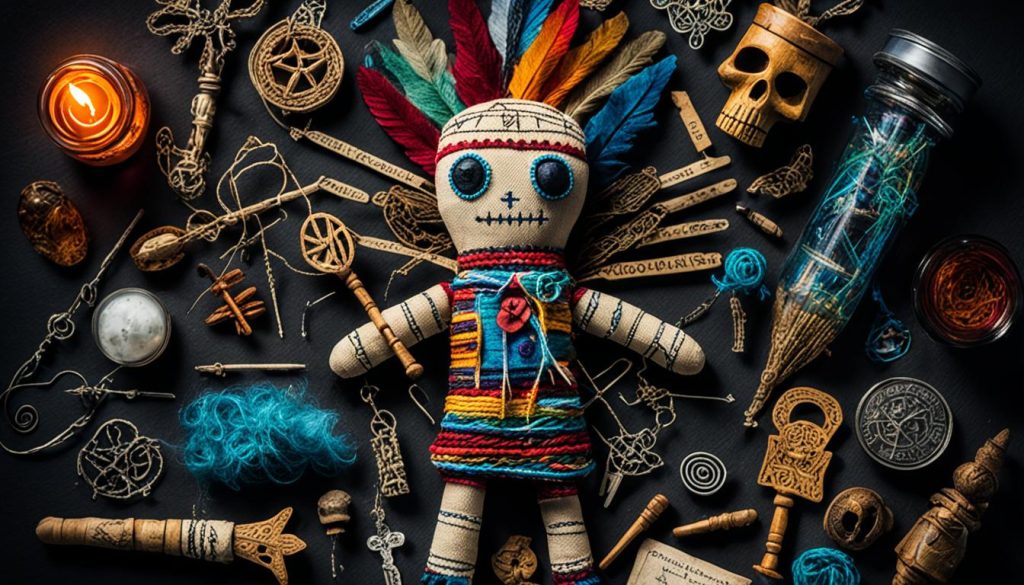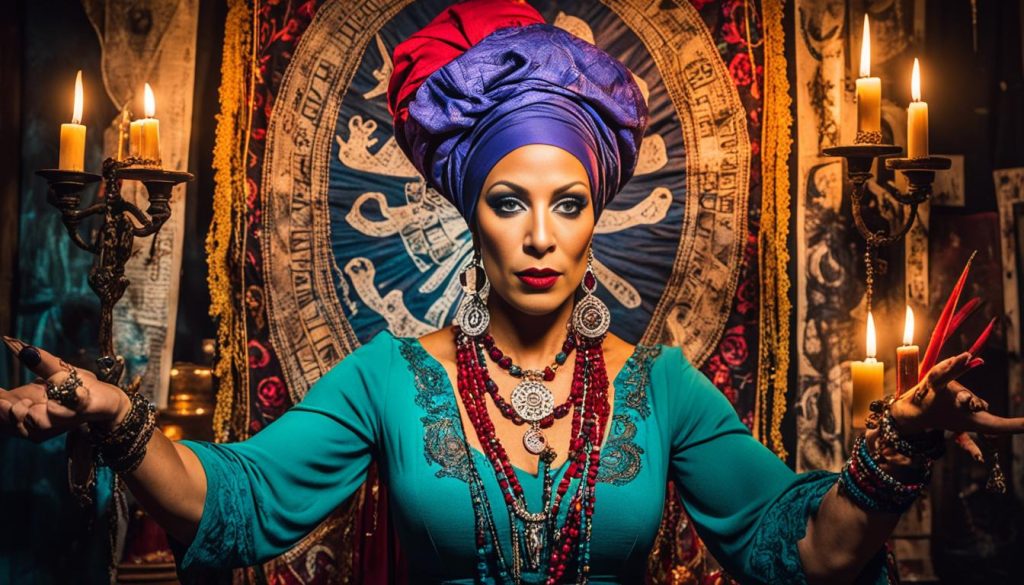Welcome to a world where African traditions, cultural influences, and the enchanting allure of Louisiana come together in a tapestry of mysticism and spirituality. Explore the rich history of Louisiana Voodoo, also known as New Orleans Voodoo, and uncover the fascinating interplay between African roots and indigenous beliefs within this unique cultural phenomenon.
Steeped in centuries-old traditions, Louisiana Voodoo emerged through the syncretism of African religions brought to Haiti by enslaved Africans and the iconography of European-derived traditions such as Roman Catholicism. This amalgamation birthed a belief system that transcends boundaries, igniting the imagination and captivating the spirit.
Central to the mythos of Louisiana Voodoo are influential figures like Marie Laveau, the renowned Voodoo Queen, and Doctor John Montanet, a pioneering practitioner. These individuals, among others, have played a significant role in shaping the perception and practice of Voodoo in New Orleans, infusing it with their wisdom and charisma.
But Louisiana Voodoo extends far beyond individual personalities. It has permeated every facet of New Orleans culture, from its music and dance to its festivals and celebrations. It has inspired literature, fascinated filmmakers, and enticed tourists from around the world. Louisiana Voodoo is not just a spiritual practice; it is a cultural force that continues to thrive today.
Journey with us as we delve into the origins, beliefs, and practices of Louisiana Voodoo. Unravel the mysteries of the Voodoo Pantheon, discover the power of Voodoo dolls and Gris-Gris bags, and explore the enduring influence of this captivating spiritual tradition on the vibrant tapestry of New Orleans culture.
The Origins and History of Louisiana Voodoo
Voodoo, with its diverse cultural influences, traces its roots back to the African traditional religions of West and Central Africa. Enslaved Africans brought these beliefs to Haiti, where they mixed with the iconography of European-derived traditions, leading to the development of a syncretic religion known as Vodou.
This fusion of African and European traditions continued to evolve, eventually making its way to Louisiana. With the arrival of enslaved Africans in the 18th and 19th centuries, Louisiana Voodoo began to take shape. It became a composite of various African ethnic traditions, influenced by Roman Catholic iconography and rituals.
The evolution of Voodoo in Louisiana was a gradual process, shaped by the cultural and religious practices of enslaved Africans, Native Americans, and the French and Spanish colonizers. As a result, Louisiana Voodoo incorporated elements from African traditional religions, Native American spiritual practices, and Catholicism.
African Roots of Voodoo
At its core, Louisiana Voodoo retains the African roots of Voodoo, carrying on the traditions brought by enslaved Africans to the Americas. These African religious practices served as a foundation for the syncretism and cultural blending that occurred in Louisiana.
The diverse African ethnic traditions that influenced Louisiana Voodoo include those of the Fon, Yoruba, Ewe, and Kongo peoples, among others. Each of these traditions contributed unique beliefs, rituals, and spiritual practices, enriching the tapestry of Louisiana Voodoo.
Syncretism and Diverse Cultural Influences
Syncretism played a vital role in shaping Louisiana Voodoo. It refers to the process of blending and adapting different religious and cultural practices into a new form of spiritual expression.
The syncretic nature of Louisiana Voodoo is evident in its incorporation of Roman Catholic iconography, rituals, and saints. This integration of Catholicism, alongside African spiritual traditions, gave rise to a unique form of Voodoo that embraced both African and European elements.
By the 20th century, Louisiana Voodoo had similarities to Haitian Vodou and Cuban Santería. Many practitioners of Louisiana Voodoo also maintained their Roman Catholic faith, practicing both religions simultaneously. This syncretism allowed for the coexistence of multiple spiritual expressions within the framework of Louisiana Voodoo.
Key Beliefs and Practices of Louisiana Voodoo
The Voodoo Pantheon is a central aspect of Louisiana Voodoo, encompassing the diverse and vibrant presence of the Loa spirits. These Loa serve as powerful intermediaries between humans and the supreme being, Bondye. Each Loa possesses unique characteristics, roles, and associated rituals, contributing to the intricate tapestry of Louisiana Voodoo.
The Voodoo Pantheon consists of different families of Loa, including Rada, Petro, and Ghede. Within these families, there are notable members such as Legba, Loco, Ayizan, Simbi, Gran Bwa, Baron Samedi, and Maman Brigitte, each revered for their specific attributes and influences. These Loa play an integral role in the Voodoo rituals and ceremonies, guiding practitioners and offering assistance in various aspects of life.
Voodoo dolls and Gris-Gris bags are significant tools utilized in Louisiana Voodoo practices. Voodoo dolls serve as potent spiritual conduits, embodying the connection between individuals and their desires. Through rituals and focused intention, practitioners believe they can influence events and manifest positive outcomes. Gris-Gris bags, on the other hand, contain an assortment of items carefully chosen for their symbolic meanings, imbuing them with unique powers. These bags are believed to bring luck, protection, and spiritual blessings to those who carry or wear them.
Embracing the Voodoo Pantheon, utilizing Voodoo dolls, and harnessing the power of Gris-Gris bags are essential elements of Louisiana Voodoo, imbued with centuries of tradition, symbolism, and spiritual significance.

Influential Figures in Louisiana Voodoo
Marie Laveau, known as the Voodoo Queen of New Orleans, holds a prominent place in the history of Louisiana Voodoo. With her unique blend of Catholicism and African spiritual practices, she played a vital role in the development and popularization of Voodoo in the city. Marie Laveau was not only a powerful practitioner but also a revered figure known for her charitable works and her ability to offer guidance and healing through her Voodoo rituals.
Another influential figure in the world of Louisiana Voodoo is Doctor John Montanet, also known as Bayou John. He made significant contributions to the early development of Voodoo in the city. Doctor John established one of the first Voodoo congregations, where he introduced the use of gris-gris, a magical talisman, in Voodoo practices.
While Marie Laveau and Doctor John Montanet were instrumental in shaping Louisiana Voodoo’s foundation, contemporary practitioners are essential for keeping the tradition alive. These devoted individuals continue to play a crucial role in preserving and propagating the rich cultural heritage of Louisiana Voodoo. Groups like the Voodoo Dispensary are dedicated to maintaining the authenticity and integrity of this ancient practice, ensuring its continued presence and relevance in today’s world.

As contemporary practitioners honor the legacy of Marie Laveau and Doctor John Montanet, Louisiana Voodoo remains a vibrant and thriving spiritual practice that continues to captivate and inspire individuals from all walks of life.
Conclusion
Louisiana Voodoo is a captivating cultural phenomenon that has intrigued people for centuries. Combining African, Catholic, and indigenous traditions, it has evolved into a unique and complex belief system. Its rich history and spiritual practices have made it a cherished part of New Orleans culture.
Key aspects of Louisiana Voodoo, such as the Voodoo Pantheon, the use of Voodoo dolls, and Gris-Gris bags, have both fascinated and mystified people. These practices offer a rare and captivating glimpse into the spiritual realm, allowing individuals to connect with the divine in a profound way.
Throughout history, influential figures like Marie Laveau and Doctor John Montanet have played significant roles in shaping the perception and practice of Voodoo in New Orleans. Their contributions have contributed to the preservation and propagation of this unique spiritual practice.
Today, Louisiana Voodoo continues to thrive and evolve, with modern practitioners carrying on the traditions of their ancestors. They are dedicated to maintaining the authenticity and integrity of Louisiana Voodoo, ensuring its cultural significance endures for generations to come.